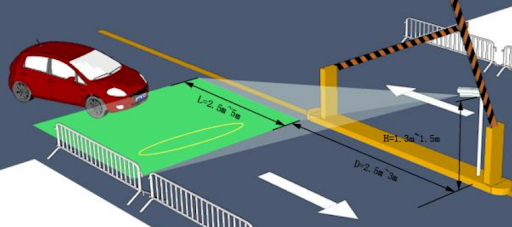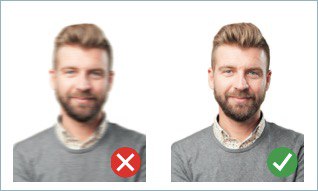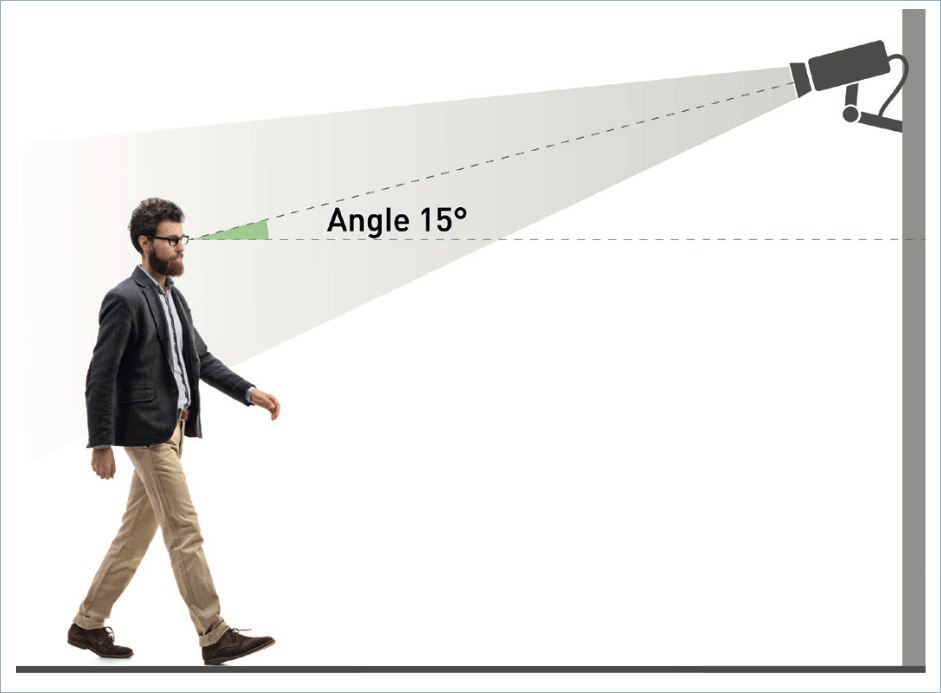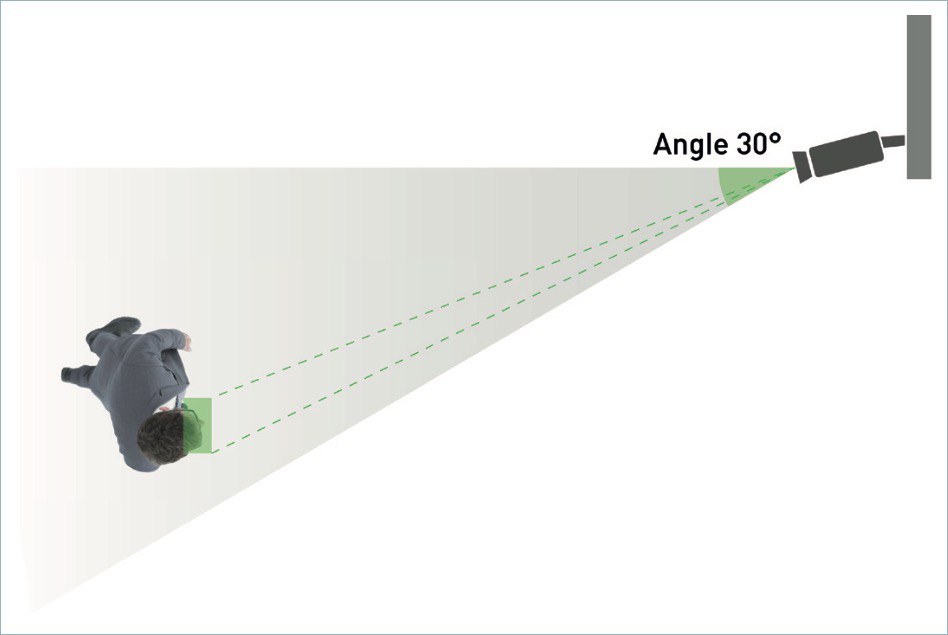STEP 1. CCTV Camera Requirements: characteristics and installation
Face recognition
CCTV Camera characteristics
The minimum pixel density required for identification is 500 pixels/m (roughly corresponds to a face width of 80 pixels).
Select such a focal length of the camera’s lenses that provides the required pixel density at a predetermined distance to the recognition objects. The picture below demonstrates how to calculate the focal length subject to the distance between the camera and recognition objects. Estimating the focal length for a particular camera requires either calculators or a methodology provided by the camera manufacturer.
The exposure must be adjusted so that the face images are sharp (“in focus”), non-blurred, and evenly lit (not overlit or too dark).
For imperfect lighting conditions such as flare, too bright or too dim illumination, choose cameras with WDR hardware (Wide Dynamic Range) or other technologies that provide compensation for backlight and low illumination. Consider BLC, HLC, DNR, high optical sensitivity, Smart infrared backlight, AGC, and such.
Video compression: most video formats and codecs that FFmpeg can decode.
Video stream delivery protocols: RTSP, HTTP.
Tip
To calculate the precise hardware configuration tailored to your purposes, contact our experts by support@ntechlab.com.
CCTV Camera installation
For correct face detection in a video stream, mount the camera so that the face of each individual entering the monitored area surely appears in the camera field of view.
The vertical tilt angle of the camera should not exceed 15°. The vertical tilt is a deviation of the camera’s optical axis from the horizontal plane, positioned at the face center’s level for an average height person (160 cm).
The horizontal deflection angle should not exceed 30°. The horizontal deflection is a deviation of the camera’s optical axis from the motion vector of the main flow of objects subject to recognition.
Vehicle recognition
CCTV Camera characteristics
General characteristics
FindFace lite requires the configuration described in the tables below.
Object in frame requirements
Parameter |
Minimal requirements |
Recommended requirements |
|---|---|---|
Object size: vehicle width |
>= 80 px |
>= 120 px |
Object size: license plate number width |
>= 100 px |
>= 150 px |
Object size: LPN + vehicle |
>= 340 px |
>= 340 px |
Object allowable overlap |
<= 30% |
<= 15% |
Camera requirements (for a digital image)
Parameter |
Minimal requirements |
Recommended requirements |
|---|---|---|
Matrix size |
>= 1/2,8 |
>= 1/1,8 |
Focal length |
>= 1,5 mm |
>= 4 mm |
Light sensitivity (color) |
<= 0.1 lux |
<= 0,05 lux |
TCP protocol |
Yes |
Yes |
Broadcast resolution |
>= 720x576 |
>= 1920x1080 |
Broadcast quality |
3000-4000 kb/s |
>= 4000 kb/s |
Frame rate |
>= 15 |
>= 50-60 |
Shutter speed |
up to 1/100 |
up to 1/500 |
H.264 support |
H.264 |
H.264, H,265 |
Keyframe frequency adjustment |
Yes |
Yes |
WDR support |
Yes |
Yes (up to 120 dB) |
Aperture adjustment |
Not required |
Yes |
Focal length adjustment |
Not required |
Yes |
Mechanical IR filter |
Not required |
Yes |
ONVIF support |
Not required |
Yes |
Сamera mounting (object in a frame allowable rotation)
Parameter |
Minimal requirements |
Recommended requirements |
|---|---|---|
Camera vertical angle |
<= 45° |
<= 30° |
Camera horizontal tilt angle (vehicle) |
Not matter |
Not matter |
Camera horizontal tilt angle (LPN) |
<= 30° |
<= 15° |
Lighting requirements
Parameter |
Minimal requirements |
Recommended requirements |
|---|---|---|
Illumination in the recognition zone |
>= 150 lux |
>= 200 lux |
Backlight compensation |
<= 200 lux |
<= 100 lux |
Broadcast camera settings requirements
Settings |
Parameter |
Recommended requirements |
|---|---|---|
Exposition |
Iris mode |
auto |
Auto iris level |
50 |
|
Exposure time |
1/200 |
|
Gain |
25 |
|
Camera focus |
Camera focus |
Should be configured manually for a specific scene |
Backlight settings |
BLC |
OFF |
WDR |
OFF |
|
HLC |
ON (for barriers camera, if collecting of vehicles attributes is not required) |
Additional characteristics
IR illumination
Highly recommended option for camera. License plate number effectively reflects lights and in low light conditions the light from camera IR will perfectly highlight the car number.
Note
IR illumination characteristics of the equipment written by the manufacturer (e.g. 10, 20, 50 meters) are the range to the complete backlight extinction.
So, the effective range is usually 30-40% lower. Please, keep that in mind.
SmartIR
If there is an IR illuminator in the camera, SmartIR option could greatly improve the quality of image in low light conditions.
SmartIR or smart IR illumination control allows you to reduce the backlight intensity if the subject is too close and the frame is overexposed.
With Smart IR

Without Smart IR

WDR (Wide Dynamic Range)
Use the WDR setting to adjust the white balance.
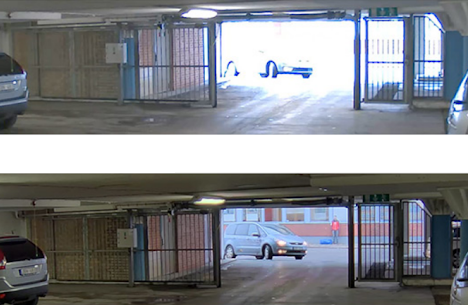
BLC (Blacklight Compensation)
Use the BLC setting to correct backlight problems.
HLC (Highlight Compensation)
Use the HLC setting to compensate for overexposed areas. HLC automatically detects redundant light sources and reduces flare, greatly improving the clarity of bright areas.
When HLC is activated, the camera will proceed bright areas such as a spotlight and adjust the exposure accordingly.
With HLC the camera will try to build the whole scene exposure correctly, reducing the brightness of overlighted areas.

CCTV camera installation
Objects in the frame should be detailed, focused, not blurred and highly contrasted.
For proper analytics follow the mounting guidelines below.
General installation recommendations
The distance from camera to recognition zone is arbitrary. Cameras with appropriate lenses are being selected depending on the distance.
Camera should be mounted to a fixed rigid construction.
Avoid sunlight or excess light in camera lens, it can lead to image flare.
Object in the frame should be completely visible. The central camera axis should approach to recognition zone center, so the object itself is in the center of the frame.
Resolution and camera lens should be clear and not blurry, without any visible distortion.
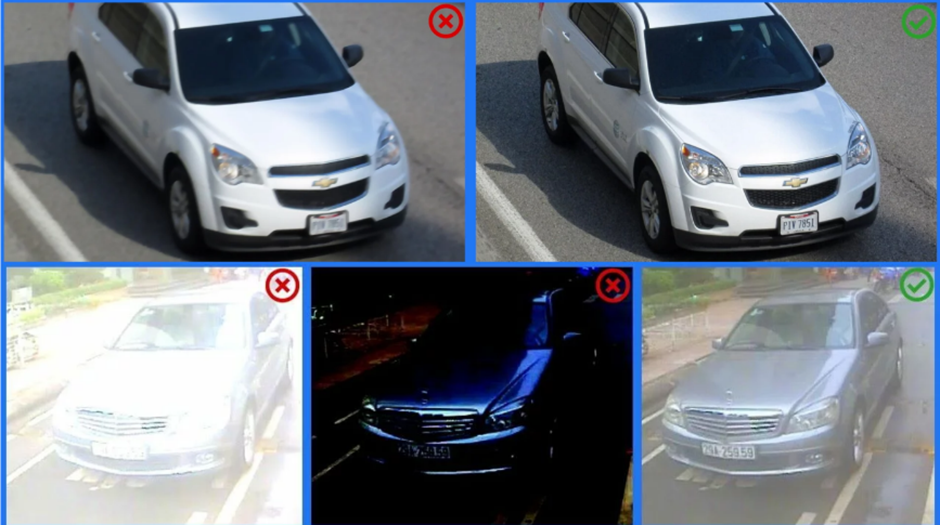
Installation on barriers
Parameters |
Requirements |
|---|---|
Installation height (H) |
1.3-1.5 m |
Distance from camera to image corner (D) |
2.5 - 3 m. |
Visible frame distance (L) |
2.5-5m |
